High Pressure Induced Insulator-to-Semimetal Transition through Intersite Charge Transfer in NaMn7O12
Abstract
:1. Introduction
2. Experimental
3. Results and Discussion
3.1. Transport Analysis
3.2. Structural Analysis
4. Conclusions
Acknowledgments
Author Contributions
Conflicts of Interest
References
- Mizokawa, T. Metal-insulator transitions: Orbital control. Nat. Phys. 2013, 9, 612–613. [Google Scholar] [CrossRef]
- Cui, C.; Tyson, T.A. Correlations between pressure and bandwidth effects in metal-insulator transitions in manganites. Appl. Phys. Lett. 2004, 84, 942–944. [Google Scholar] [CrossRef]
- Yoo, C.S.; Maddox, B.; Klepeis, J.-H.P.; Iota, V.; Evans, W.; McMahan, A.; Hu, M.Y.; Chow, P.; Somayazulu, M.; Hausermann, D.; et al. First-Order isostructural mott transition in highly compressed MnO. Phys. Rev. Lett. 2005, 94, 115502. [Google Scholar] [CrossRef] [PubMed]
- Yasui, Y.; Sasaki, H.; Sato, M.; Ohashi, M.; Sekine, Y.; Murayama, C.; Môri, N. Studies of pressure-induced mott metal-insulator transition of BaCoS2. J. Phys. Soc. Jpn. 1999, 68, 1313–1320. [Google Scholar] [CrossRef]
- Orii, D.; Sakata, M.; Miyake, A.; Shimizu, K.; Okabe, H.; Isobe, M.; Takayama-Muromachi, E.; Akimitsu, J. Pressure-induced metal-insulator transition of the Mott insulator Ba2IrO4. J. Korean Phys. Soc. 2013, 63, 349–351. [Google Scholar] [CrossRef]
- Nakamura, F.; Goko, T.; Ito, M.; Fujita, T.; Nakatsuji, S.; Fukazawa, H.; Maeno, Y.; Alireza, P.; Forsythe, D.; Julian, S.R. From Mott insulator to ferromagnetic metal: A pressure study of Ca2RuO4. Phys. Rev. B 2002, 65, 220402. [Google Scholar] [CrossRef]
- Oike, H.; Miyagawa, K.; Taniguchi, H.; Kanoda, K. Pressure-Induced mott transition in an organic superconductor with a finite doping level. Phys. Rev. Lett. 2015, 114, 067002. [Google Scholar] [CrossRef] [PubMed]
- Dai, L.D.; Wu, L.; Li, H.P.; Hu, H.Y.; Zhuang, Y.K.; Liu, K.X. Evidence of the pressure-induced conductivity switching of yttrium-doped SrTiO3. J. Phys. Condens. Matter 2016, 28, 475501. [Google Scholar] [CrossRef] [PubMed]
- Ishiwata, S.; Azuma, M.; Takano, M. Pressure-induced metal-insulator transition in BiNiO3. Solid State Ion. 2004, 172, 569–571. [Google Scholar] [CrossRef]
- Cai, M.Q.; Yang, G.W.; Tan, X.; Cao, Y.L.; Wang, L.L.; Hu, W.Y.; Wang, G. Vacancy-driven ferromagnetism in ferroelectric PbTiO3. Appl. Phys. Lett. 2007, 91, 101901. [Google Scholar] [CrossRef]
- Cheng, J.; Kweon, K.E.; Larregol, S.A.; Ding, Y.; Shirako, Y.; Marshall, L.G.; Li, Z.-Y.; Li, X.; dos Santos, A.M.; Suchomel, M.R.; et al. Charge disproportionation and the pressure-induced insulator-metal transition in cubic perovskite PbCrO3. Proc. Natl. Acad. Sci. USA 2015, 112, 1670–1674. [Google Scholar] [CrossRef] [PubMed] [Green Version]
- Medarde, M.; Mesot, J.; Lacorre, P.; Rosenkranz, S.; Fischer, P.; Gobrecht, K. High-pressure neutron-diffraction study of the metallization process in PrNiO3. Phys. Rev. B 1995, 52, 9248. [Google Scholar] [CrossRef]
- Occelli, F.; Farber, D.L.; Badro, J.; Aracne, C.M.; Teter, D.M.; Hanfland, M.; Canny, B.; Couzinet, B. Experimental evidence for a high-pressure isostructural phase transition in osmium. Phys Rev. Lett. 2004, 93, 095502. [Google Scholar] [CrossRef] [PubMed] [Green Version]
- Liu, Q.; Yu, X.; Wang, X.; Deng, Z.; Lv, Y.; Zhu, J.; Zhang, S.; Liu, H.; Yang, W.; Wang, L.; et al. Pressure-Induced isostructural phase transition and correlation of FeAs coordination with the superconducting properties of 111-Type Na1-xFeAs. J. Am. Chem. Soc. 2011, 133, 7892–7896. [Google Scholar] [CrossRef] [PubMed]
- Arcangeletti, E.; Baldassarre, L.; Di Castro, D.; Lupi, S.; Malavasi, L.; Marini, C.; Perucchi, A.; Postorino, P. Evidence of a pressure-induced metallization process in monoclinic VO2. Phys. Rev. Lett. 2007, 98, 196406. [Google Scholar] [CrossRef] [PubMed]
- Wang, X.; Chen, X.; Zhou, Y.; Park, C.; An, C.; Zhou, Y.; Zhang, R.; Gu, C.; Yang, W.; Yang, Z. Pressure-induced iso-structural phase transition and metallization in WSe2. Sci. Rep. 2017, 7, 46694. [Google Scholar] [CrossRef] [PubMed]
- Chi, Z.H.; Zhao, X.M.; Zhang, H.; Goncharov, A.F.; Lobanov, S.S.; Kagayama, T.; Sakata, M.; Chen, X.J. Pressure-induced metallization of molybdenum disulfide. Phys. Rev. Lett. 2014, 113, 036802. [Google Scholar] [CrossRef] [PubMed]
- Fuhr, J.D.; Avignon, M.; Alascio, B. Pressure-Induced Insulator-Metal Transition in LaMnO3: A Slave-Boson Approach. Phys. Rev. Lett. 2008, 100, 216402. [Google Scholar] [CrossRef] [PubMed]
- Loa, I.; Adler, P.; Grzechnik, A.; Syassen, K.; Schwarz, U.; Hanfland, M.; Rozenberg, G.K.; Gorodetsky, P.; Pasternak, M.P. Pressure-Induced quenching of the jahn-teller distortion and insulator-to-metal transition in LaMnO3. Phys. Rev. Lett. 2001, 87, 125501. [Google Scholar] [CrossRef] [PubMed]
- Moritomo, Y.; Kuwahara, H.; Tomioka, Y. Pressure effects on charge-ordering transitions in perovskite manganites. Phys. Rev. B 1997, 55, 7549–7556. [Google Scholar] [CrossRef]
- Arumugam, S.; Thiyagarajan, R.; Kalaiselvan, G.; Sivaprakash, P. Pressure induced insulator-metal transition and giant negative piezoresistance in Pr0.6Ca0.4Mn0.96Al0.04O3 polycrystal. J. Magn. Magn. Mater. 2016, 417, 69–74. [Google Scholar] [CrossRef]
- Streltsov, S.V.; Khomskii, D.I. Jahn-Teller distortion and charge, orbital, and magnetic order in NaMn7O12. Phys. Rev. B 2014, 89, 201115. [Google Scholar] [CrossRef]
- Marezio, M.; Dernier, P.D.; Chenavas, J.; Joubert, J.C. High pressure synthesis and crystal structure of NaMn7O12. J. Solid State Chem. 1973, 6, 16–20. [Google Scholar] [CrossRef]
- Bochu, B.; Buevoz, J.L.; Chenavas, J.; Collomb, A.; Joubert, J.C.; Marezio, M. Bond lengths in ‘CaMn3’ (Mn4)O12: A new Jahn-Teller distortion of Mn3+ octahedra. Solid State Commun. 1980, 36, 133–138. [Google Scholar] [CrossRef]
- Belik, A.; Glazkova, Y.K.; Katsuya, Y.; Tanaka, M.; Sobolev, A.V.; Presniakov, A. Low-Temperature structural modulations in CdMn7O12, CaMn7O12, SrMn7O12, and PbMn7O12 perovskites studied by synchrotron X-ray powder diffraction and mössbauer spectroscopy. J. Phys. Chem. C 2016, 120, 8278–8288. [Google Scholar] [CrossRef]
- Locherer, T.; Dinnebier, R.; Kremer, R.K.; Greenblatt, M.; Jansen, M. Synthesis and properties of a new quadruple perovskite: A-site ordered PbMn3Mn4O12. J. Solid State Chem. 2012, 190, 277–284. [Google Scholar] [CrossRef]
- Prodi, A.; Gilioli, E.; Cabassi, R.; Bolzoni, F.; Licci, F.; Huang, Q.; Lynn, J.W.; Affronte, M.; Gauzzi, A.; Marezio, M. Magnetic structure of the high-density Single-Valent eg Jahn-Teller system LaMn7O12. Phys. Rev. B 2009, 79, 085105. [Google Scholar] [CrossRef]
- Liu, X.J.; Lv, S.H.; Pan, E.; Meng, J.; Albrecht, J.D. First-principles study of crystal structural stability and electronic and magnetic properties in LaMn7O12. J. Phys. Condens. Matter 2010, 22, 246001. [Google Scholar] [CrossRef] [PubMed]
- Mezzadri, F.; Calestani, G.; Calicchio, M.; Gilioli, E.; Bolzoni, F.; Cabassi, R.; Marezio, M.; Migliori, A. Synthesis and characterization of multiferroic BiMn7O12. Phys. Rev. B 2009, 79, 100106. [Google Scholar] [CrossRef]
- Mezzadri, F.; Buzzi, M.; Pernechele, C.; Calestani, G.; Solzi, M.; Migliori, A.; Gilioli, E. Polymorphism and Multiferroicity in Bi1–x/3(MnIII3)(MnIII4–xMnIVx)O12. Chem. Mater. 2011, 23, 3628–3635. [Google Scholar] [CrossRef]
- Verseils, M.; Mezzadri, F.; Delmonte, D.; Baptiste, B.; Klein, Y.; Shcheka, S.; Chapon, L.C.; Hansen, T.; Gilioli, E.; Gauzzi, A. Effect of chemical pressure induced by La3+/Y3+ substitution on the magnetic ordering of (AMn3)Mn4O12 quadruple perovskite. Phys. Rev. Mater. 2017, 1, 064407. [Google Scholar] [CrossRef]
- Mezzadri, F.; Calicchio, M.; Gilioli, E.; Cabassi, R.; Bolzoni, F.; Calestani, G.; Bissoli, F. High-pressure synthesis and characterization of PrMn7O12 polymorphs. Phys. Rev. B 2009, 79, 014420. [Google Scholar] [CrossRef]
- Prodi, A.; Gilioli, E.; Gauzzi, A.; Licci, F.; Marezio, M.; Bolzoni, F.; Huang, Q.; Santoro, A.; Lynn, J. Charge, orbital and spin ordering phenomena in the mixed valence manganite (NaMn3+3)(Mn3+2Mn4+2)O12. Nat. Mater. 2004, 3, 48–52. [Google Scholar]
- Prodi, A.; Daoud-Aladine, A.; Gozzo, F.; Schmitt, B.; Lebedev, O.; van Tendeloo, G.; Gilioli, E.; Bolzoni, F.; Aruga-Katori, H.; Takagi, H.; et al. Commensurate structural modulation in the charge- and orbitally ordered phase of the quadruple perovskite (NaMn3)Mn4O12. Phys. Rev. B 2014, 90, 180101. [Google Scholar] [CrossRef]
- Gilioli, E.; Calestani, G.; Licci, F.; Gauzzi, A.; Bolzoni, F.; Prodi, A.; Marezio, M. P–T phase diagram and single crystal structural refinement of NaMn7O12. Solid State Sci. 2005, 7, 746–752. [Google Scholar] [CrossRef]
- Merlini, M.; Hanfland, M. Single-crystal diffraction at megabar conditions by synchrotron radiation. High Press. Res. 2013, 33, 511–522. [Google Scholar] [CrossRef]
- Sheldrick, G.M. Crystal structure refinement with SHELXL. Acta Crystallogr. C 2015, 71, 3–8. [Google Scholar] [CrossRef] [PubMed]
- Brown, I.D.; Altermatt, D. Bond-valence parameters obtained from a systematic analysis of the Inorganic Crystal Structure Database. Acta Crystallogr. B 1985, 41, 244–247. [Google Scholar] [CrossRef]
- Long, Y.; Kawakami, T.; Chen, W.; Saito, T.; Watanuk, T.; Nakakura, Y.; Liu, Q.; Jin, C.; Shimakawa, Y. Pressure effect on intersite charge transfer in a-site-ordered double-perovskite-structure oxide. Chem. Mater. 2012, 24, 2235–2239. [Google Scholar] [CrossRef]
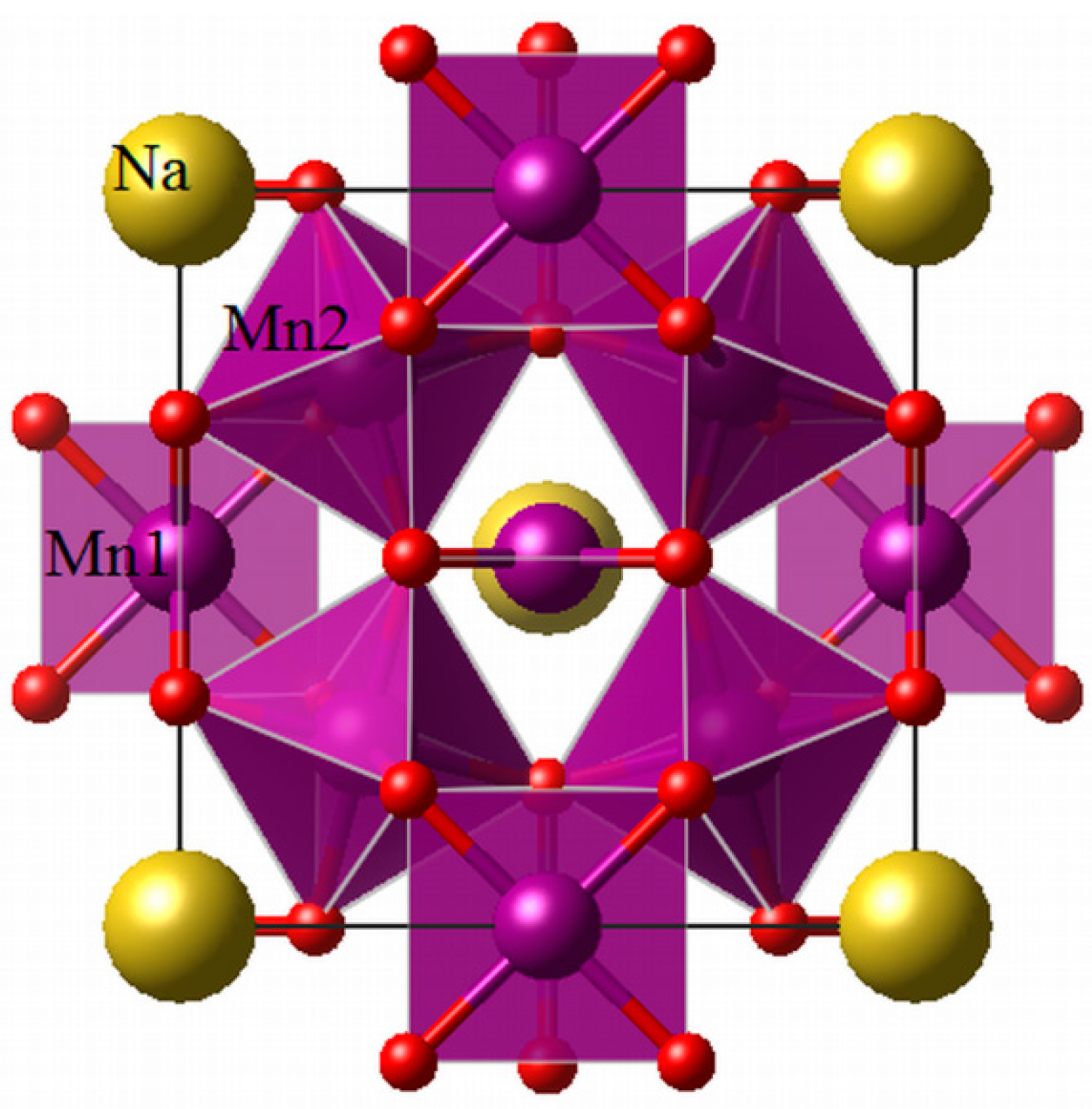
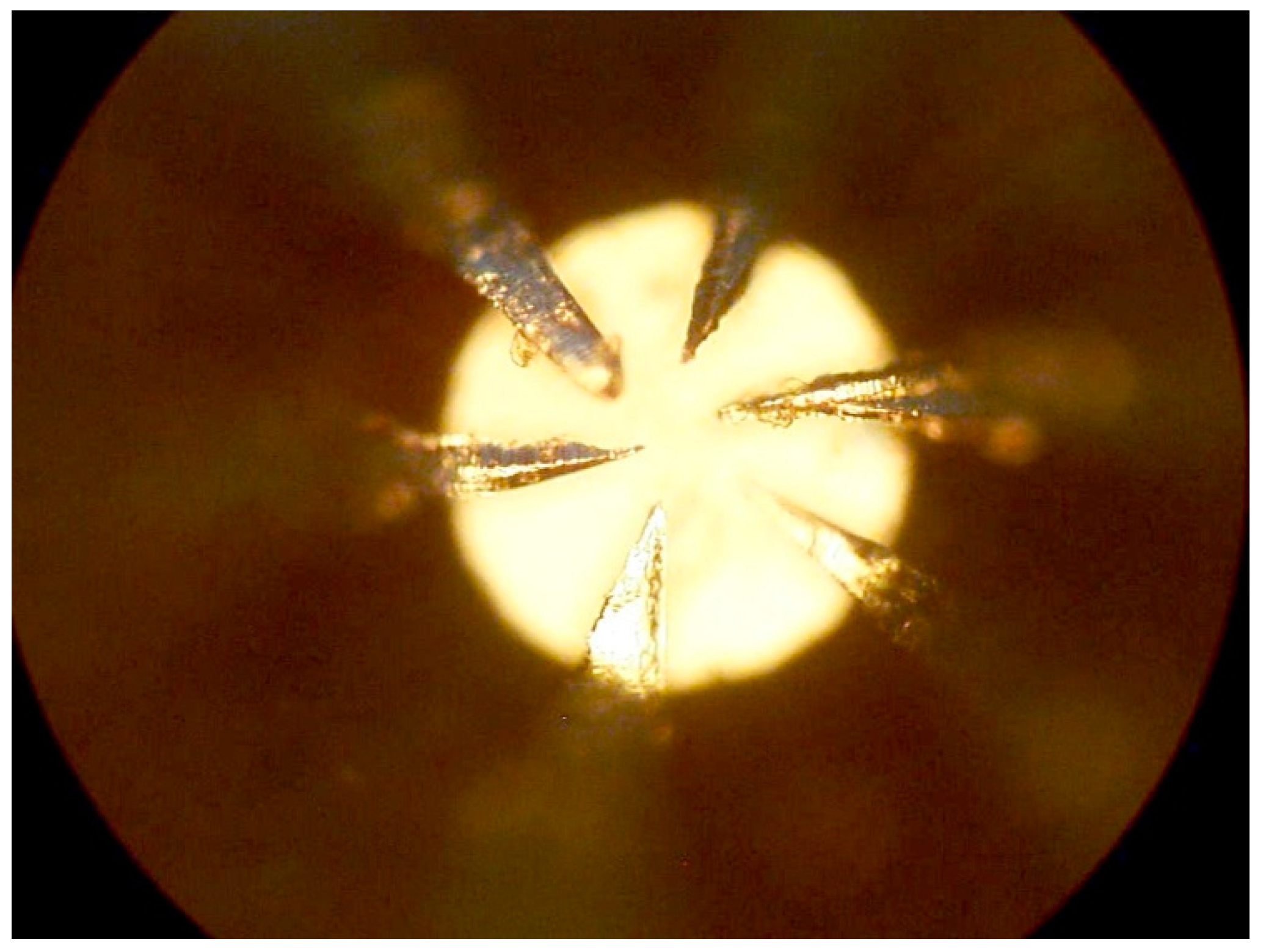
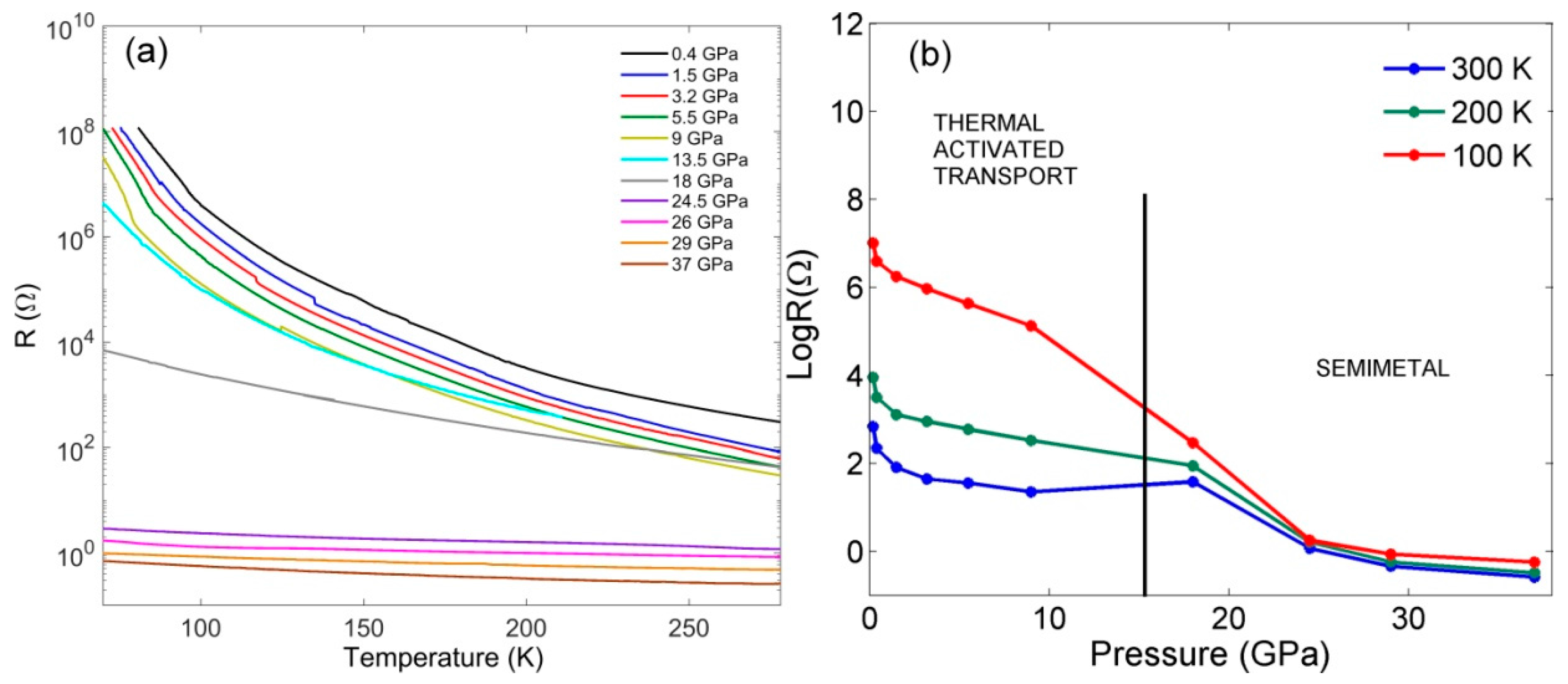


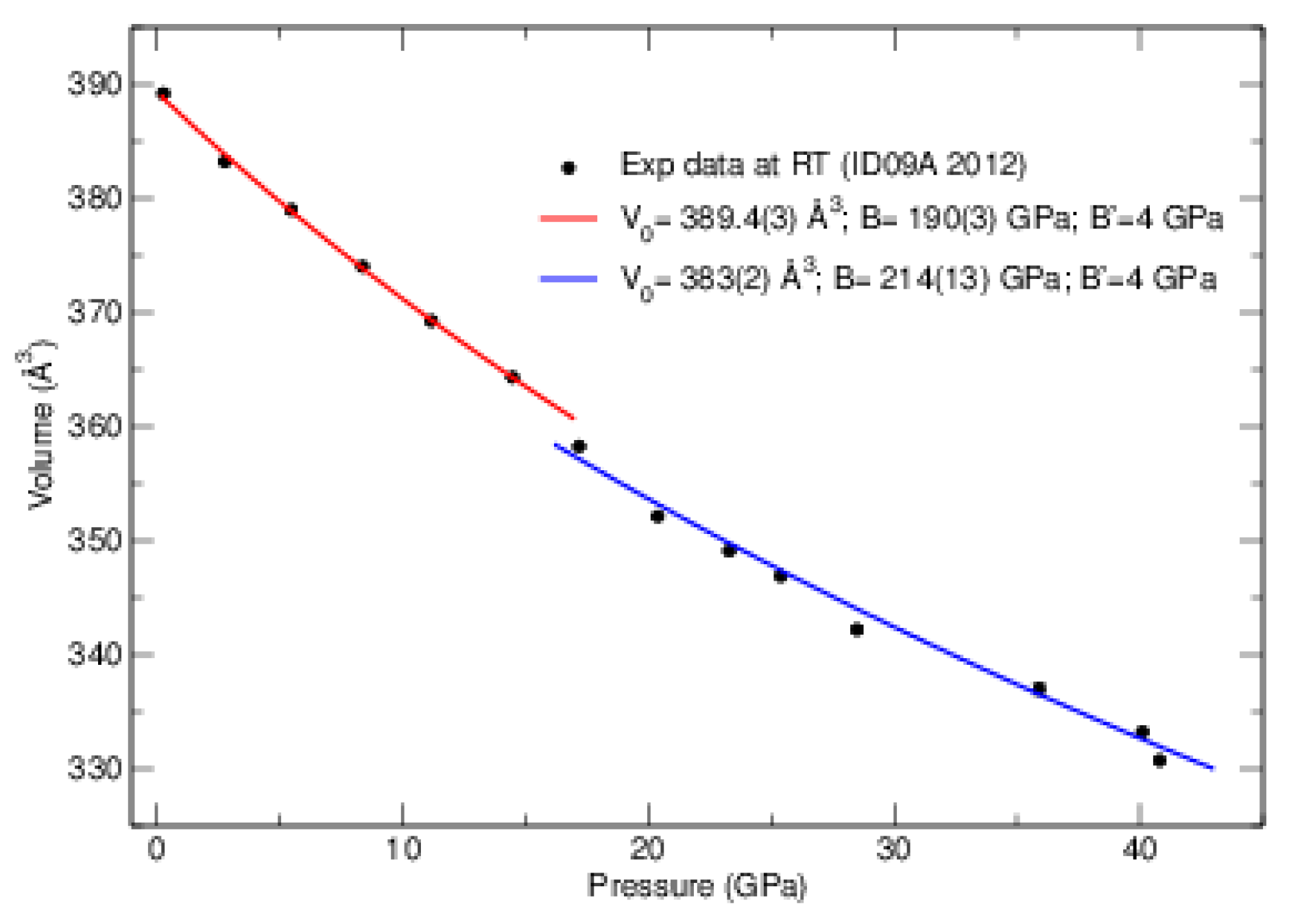
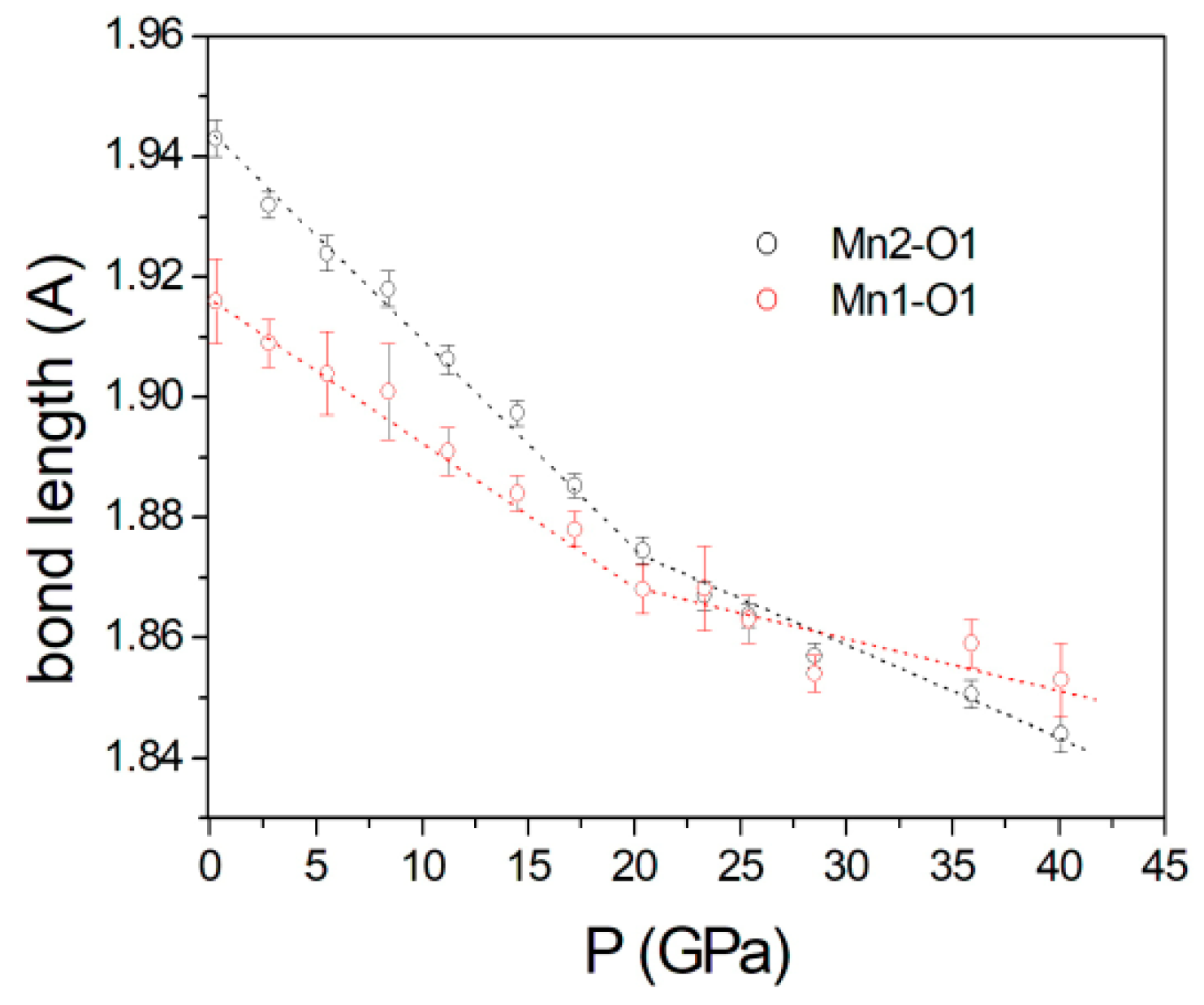
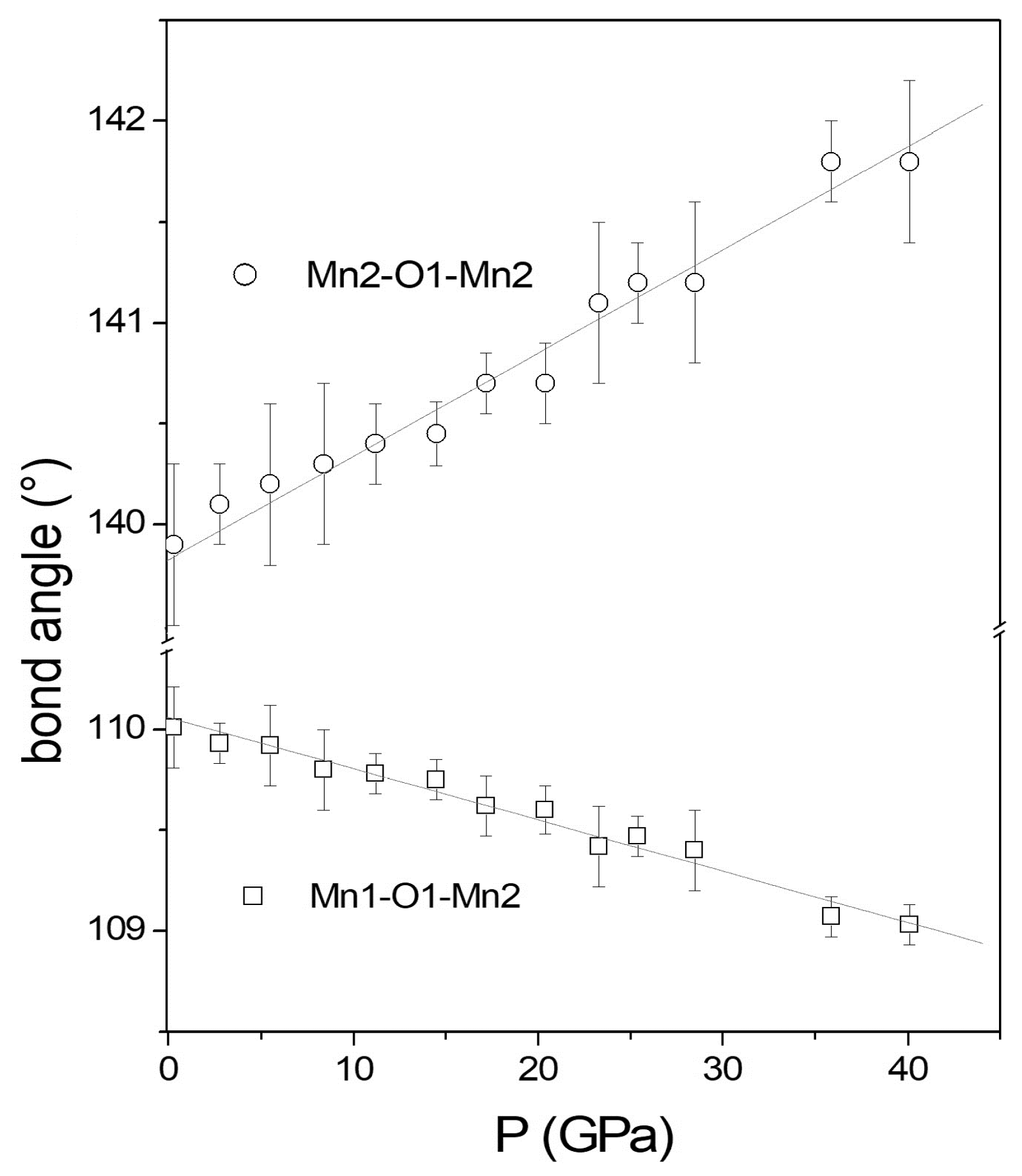

| P (GPa) | a (Å) | V (Å2) | Na1-O1 (Å) | Mn1-O1 (Å) | Mn1-O1 (Å) | Avg. Mn1-O1 | Mn2-O1 (Å) | Mn2-O1-Mn2 (°) |
|---|---|---|---|---|---|---|---|---|
| 0.3 | 7.301(2) | 389.2(9) | 2.644(7) | 1.943(2) | 2.6867(6) | 2.3149(10) | 1.916(7) | 139.9(4) |
| 2.8 | 7.264(2) | 383.2(9) | 2.629(4) | 1.9320(15) | 2.6734(6) | 2.3027(8) | 1.909(4) | 140.1(2) |
| 5.5 | 7.237(2) | 379.0(9) | 2.618(7) | 1.924(3) | 2.6648(6) | 2.2944(15) | 1.904(7) | 140.2(4) |
| 8.4 | 7.205(2) | 374.0(9) | 2.605(8) | 1.918(3) | 2.6610(12) | 2.2895(16) | 1.901(8) | 140.3(4) |
| 11.2 | 7.174(2) | 369.3(9) | 2.593(4) | 1.9063(14) | 2.6411(6) | 2.2737(8) | 1.891(4) | 140.4(2) |
| 14.5 | 7.142(2) | 364.3(9) | 2.582(3) | 1.8974(11) | 2.629(6) | 2.263(3) | 1.884(3) | 140.45(16) |
| 17.2 | 7.102(2) | 358.3(9) | 2.566(3) | 1.8853(10) | 2.6128(6) | 2.2491(6) | 1.878(3) | 140.70(15) |
| 20.4 | 7.062(2) | 352.2(9) | 2.546(4) | 1.8745(13) | 2.6042(6) | 2.2394(7) | 1.868(4) | 140.7(2) |
| 23.3 | 7.041(2) | 349.1(9) | 2.538(7) | 1.867(2) | 2.5932(6) | 2.2301(10) | 1.8682(7) | 141.1(4) |
| 25.4 | 7.026(2) | 346.9(9) | 2.534(4) | 1.8637(14) | 2.5881(6) | 2.2259(8) | 1.863(4) | 142.0(2) |
| 28.5 | 6.995(2) | 342.3(9) | 2.537(11) | 1.857(10) | 2.5606(6) | 2.2088(6) | 1.854(3) | 141.2(6) |
| 35.9 | 6.959(2) | 333.2(9) | 2.516(4) | 1.8510(13) | 2.5763(6) | 2.2135(7) | 1.859(4) | 141.8(2) |
| 40.1 | 6.933(2) | 330.7(9) | 2.490(6) | 1.834(2) | 2.5566(6) | 2.1953(10) | 1.853(6) | 141.8(4) |
© 2018 by the authors. Licensee MDPI, Basel, Switzerland. This article is an open access article distributed under the terms and conditions of the Creative Commons Attribution (CC BY) license (http://creativecommons.org/licenses/by/4.0/).
Share and Cite
Delmonte, D.; Mezzadri, F.; Orlandi, F.; Calestani, G.; Amiel, Y.; Gilioli, E. High Pressure Induced Insulator-to-Semimetal Transition through Intersite Charge Transfer in NaMn7O12. Crystals 2018, 8, 81. https://doi.org/10.3390/cryst8020081
Delmonte D, Mezzadri F, Orlandi F, Calestani G, Amiel Y, Gilioli E. High Pressure Induced Insulator-to-Semimetal Transition through Intersite Charge Transfer in NaMn7O12. Crystals. 2018; 8(2):81. https://doi.org/10.3390/cryst8020081
Chicago/Turabian StyleDelmonte, Davide, Francesco Mezzadri, Fabio Orlandi, Gianluca Calestani, Yehezkel Amiel, and Edmondo Gilioli. 2018. "High Pressure Induced Insulator-to-Semimetal Transition through Intersite Charge Transfer in NaMn7O12" Crystals 8, no. 2: 81. https://doi.org/10.3390/cryst8020081





